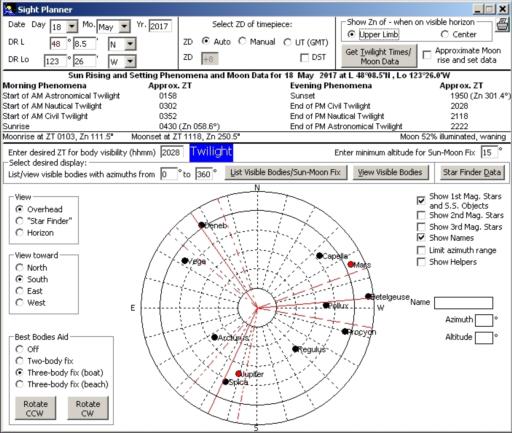
NavList:
A Community Devoted to the Preservation and Practice of Celestial Navigation and Other Methods of Traditional Wayfinding
Re: Pub. 249 question
From: Stan K
Date: 2017 Nov 27, 17:19 -0500
From: Stan K
Date: 2017 Nov 27, 17:19 -0500
Attached is the Celestial Tools Sight Planner "View Visible Bodies" screen set up for Ron's conditions (just the 3-body case). 2nd and 3rd magnitude stars are turned off. The "Best Bodies Aid" is turned on in the "Three-body fix (boat)" mode, where the three solid red lines mark the ideal 120º azimuth separations. (The two matched pairs of broken lines define the limits for Power Squadrons sight folders.) No question that Deneb, Spica, and Pollux are the best choices for a 3-star fix, properly separated in azimuth and all at good altitudes (well, some might say that Deneb is too low - by USPS rules, bodies with altitudes under 15º need to have non-standard temperature and pressure considered). However, rotating the red lines around a bit shows that Vega, Jupiter, and Mars would work, though Mars is even lower than Vega. There are a couple of other reasonable combinations.
Stan
-----Original Message-----
From: Ron Jones <NoReply_RonJones@fer3.com>
To: slk1000 <slk1000@aol.com>
Sent: Mon, Nov 27, 2017 4:15 pm
Subject: [NavList] Re: Pub. 249 question
Attached File:
Ediz-Hook-18-May-2017-Sight-Planning.pdf
From: Ron Jones <NoReply_RonJones@fer3.com>
To: slk1000 <slk1000@aol.com>
Sent: Mon, Nov 27, 2017 4:15 pm
Subject: [NavList] Re: Pub. 249 question
Using the "Sight Planning" worksheet in my "Celestial Navigation" Excel workbook for a sight planning exercise on the evening of 18 May 2017 at Ediz Hook (Lat 48° 8.5' N Lon 123° 26' W).
I found that the "best " stars for a 2 body fix are REGULUS & CAPELLA which produce LOP crossing angles of 87°and the "best" stars for a 3 body fix are DENEB, SPICA, & POLLUX which produce an azimuth spread of 238° with LOP azimuth dispersion angles of approximately 120° between each the 3 LOPs . (see attached "Ediz Hook 18 May 2017 Sight Planning.pdf")
My H.O. 249 Volume I (EPOCH 1975.0) for Lat = 48°N & GHA of Aries = 180° List the following seven stars:
{at}DENEB , VEGA, ARCTURUS, {at}SPICA, REGULUS, {at}POLLUX, CAPELLA ... . all of which are magnitude 1 stars. The stars suitable for a 3 body fix are designated by the {at} symbol. Of the 41 stars used in Volume I of H.O. 249 .... 20 are above the horizon at Ediz Hook on Greenwich Date 19 May 2003 {at} 04:28:24 GMT . Question, was a manual process such, as the one used by the "Sight Planning" worksheet in my "Celestial Navigation" Excel workbook, used to select the seven stars, or was an algorithm used? I am interested in finding the algorithm used by Volume I HO 249 for star selection, if one exist.
To download the "Celestial Navigation" workbook go to https:\uspsd16.org & select "Dept Info" and from the drop down menu select "Educational" & under the "Quizzes | Workbooks | Software" section & click on "Celestial Navigation".
Attached File:
Ediz-Hook-18-May-2017-Sight-Planning.pdf







